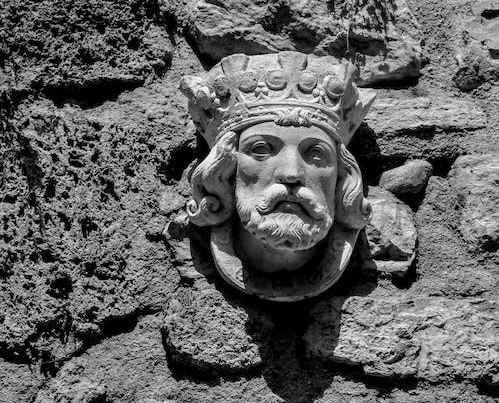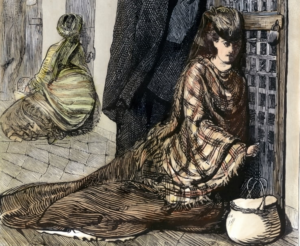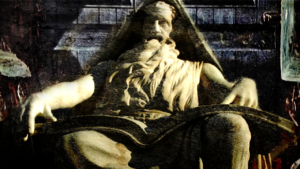Mythological Thinking and the Coronation of King Charles

People of antiquity judged and interacted with the external world in a significantly different way than do modern people, using (so-called) mythological thinking, and not thinking typical of the modern age, which is usually referred to as logical-empirical or “scientific” thinking.
The two authors today (largely in disagreement) who promulgate the most common views on primitive thinking are Levy-Bruhl and K. Levi-Straus. Levy-Bruhl labels the older mode of thinking as “prelogical” (emotional-associative) – and the modern as “logical”. K. Levi-Strauss considers them as two essentially different types of logical thinking that he labels “bricolage” and “engineering”. At the same time, in essence, the reconstruction of primitive thinking by K. Levi-Strauss largely coincides with that of Levy-Bruhl, and the differences between them relate primarily to the understanding of the category of “logical”.
To clarify the difference between the alleged “magic” and “scientific” ways of constructing judgments about the world, it is necessary to give the following conditional scheme for the development of reality by human consciousness. The primary level is the fixation of individual impressions (including emotional ones) produced by observation of reality. Primary connections are established between these impressions; they are grouped and correlated with each other on the basis of association and analogization (both in similarity and in opposition); they are also subject to a broader ordering and classification. The latter process can be either unconsciously or consciously intuitive – including the conscious selection of significant features and comparison of objects endowed with them.
As it turns out, this ordering and classification is carried out according to consistent internal principles; they have a certain internal logic (both implicit and conscious) which allows the school of K. Levi-Strauss to claim these operations as evidence of logical thinking. A system of interconnected images of various objects and processes is created in human perception, working primarily by association (including the emotions evoked by these associations).
The separation of personal (even ethical) consciousness from the collective as a crux in the transition from “pre-axial” to “axial” cultures is another common claim that, from our point of view, does not find confirmation in the sources. In the texts of the “pre-axial” archaic (from Theognis in Greece and the Epic of Gilgamesh and the Dialogue of Master and Slave in Babylonia to the Laws of Manu in India and the writings of the early Confucian Xun-tzu in China) the human world is drawn exclusively as the world of individuals making individual choices. That is both in relation to society and in relation to deities, and other personalities. They strive to satisfy their fundamental needs, and it is precisely because of this (given the initial structure of these needs) that they constitute a society, the meaning and highest authority of which is measured precisely by the fact that it is the most important and indispensable means of ensuring and protecting these needs.
Submission to the social norm is depicted in these texts as a matter of conscious, responsible and difficult personal choice (often forced!). By no means do we see the implementation of some kind of “natural” dissolution of individuality for ‘the team’, or the “swarm principle”. At the same time, the individual is portrayed as existentially lonely and not a conformist to anything other than his own needs. Naturally these needs included, from time to time, empathic/collectivist needs inherent in man by nature.
The first historical examples of concepts that consider the sacrificial self-subordination of a person to a certain transpersonal principle (a polis or a deity) are the polis ethics of the Greek classics and those of Judaism (the famous “Athens and Jerusalem”). That is: precisely the “axial” concepts! In fact, the “axial time” takes the greatest step towards the depersonalization of man. By insisting initially on the absolute subordination of individual choice to the requirements of a priori, a self-sufficient principle, as the highest and unconditional ethical imperative for any individual. The very “self-denial” in the name of the absolute beginning the individual must produce personally.
What does the collective demand from the individual in the conditions of the “pre-axial” archaism, which it does not require from a citizen of the most liberal state of our time? Any modern democratic society, when ‘necessary’, forces its members to servile compliance or sends its members to death for the good of the social collective as a whole (in practice, often identified with the good of the elites). Undoubtedly, archaic societies reached an immeasurably greater scope in this respect, which gives the modern observer the impression of a different principle in dealing with people, but in fact the difference here is in circumstances, not in principles. The real difference between the modern and the “pre-modern” model lies in the fact that within the modern society, although it has the highest authority in relation to any individual, it justifies this authority only by providing the fundamental needs of its members; the purpose of the community is not the improvement, transformation or (re)education of its participants, but their optimal survival. Accordingly, society is mainly interested only in practically significant aspects of the behavior of its members. Therefore, the ideology encouraged by the state plays an important integrating role, but does not require individual consent.
Strictly speaking, the pagan “religion” of antiquity corresponds to the modern in its purpose of providing physical benefits for society and its members, organization (temple), mode of existence (polyconceptuality, dogmatism, relativism, peaceful coexistence of many cults, syncretism, lack of ideological coloring) and self-awareness of their keepers (priestly professionalism) is not at all modern religion, but modern applied science and high-tech production; they did not know the concept of an unverifiable “revelation”, they are pragmatic in terms of the purpose of existence and eschew any principled irrationalism. A modern nuclear power plant would be typologically isomorphic to an ancient temple if physicists, for example, recognizing nuclear energy as an animated rational being with (rational) attempts to negotiate with it as such (on a verbal level and using the principle do ut des – the main principle of communication with deities in antiquity).
It is characteristic that in early antiquity people enter into contact with deities and other spirits in no way for the sake of approaching the deity, ethical purification, or improvement, but for the sake of obtaining the most ordinary and essential worldly benefits for themselves. In other words, an archaic person, in contrast to the bearer of axial-post-axial worldviews, occupies an emphatically “autocentric” and not a theocentric or genocentric one, which is often attributed to him. Of course, the deity evoked a living (though disinterested) human attitude towards itself (it could also be loved), but not to a greater extent than other living beings, and for the same non-conditional reasons.
Only in the “axial time” did elements of the dogmatization and ethization of religions (more precisely, the theologization of ethics) develop, eventually leading to the creation of dogmatic ethical religious ideologies of revelation based on faith, claiming to subjugate all spheres of society and requiring a consistently theocentric worldview orientation.
Power relations are a key element of all social formations and exist among all living beings. In the social sciences, the word “power” is often replaced by the words “influence”, “control” or “authority”. However, these words are not synonymous with the ambiguous word “power”, which is often saturated with various symbolic and religious connotations. Political power finds its expression in symbols of political independence and sovereignty, military power in combat and military symbols, while religious power is represented by signs and symbols associated with the images of deities and their attributes. And it is the development of symbols that is extremely important for the formation of various forms of power. Filled with many collective emotional connotations, symbols of power influence the human consciousness and subconscious. Thus, they take root in the minds of subordinates. No power can be maintained for a long period of time without creating and strengthening the powerful symbolic foundations of its regime.
The lords and original kings of archaic societies were considered to be filled with special superhuman strength (mana). Doctors (sorcerers), magicians and shamans were considered so saturated with such power that they were able to impregnate various objects with it. In West Africa, mana-infused items were considered to be the seat of power and bring good luck. Within the framework of animistic ideas, such objects (fetishes) were revered as symbols of the spiritual power that was supposed to be contained in them. Animals, which were associated with some deities, were also considered symbols of divine power. Therefore, the rulers received some special parts of these animals: the skin of a lion, the skin of a raven, bull horns, eagle feathers, etc. They were supposed to convey to the owner the qualities attributed to this animal, and thereby the qualities of the deity associated with it. One of the most ancient symbols of power is a pillar (column). It was considered to be descended from a god and was a symbol of Dionysus in Thebes and Apollo in Delphi, but also a symbol of world domination (for example, the victory column of the Roman emperor Trajan) and some cities (Roland’s column in Germany, representing city authorities).
Architectural symbols use the symbolism of space and form, especially the symbolism of center and height. The center symbolizes universality, completeness, absolute reality, true being and the starting point of all things. For this reason, the center is considered a sacred place containing the potential of everything. It could be seen as a breakthrough in space, or as a place to overcome space and time, in which all contradictions disappear. The evaluative value of the center, as well as the value of “highest”, “preceding”, “nearest”, is exceptionally positive in all cultures, which shows the epistemological and evaluative superiority of these spatial concepts. The castle is often presented in stories and dreams as a symbol of reliability and protection. It is usually located on a hilltop or in a tree-lined clearing in the middle of a forest. It is a solid structure that is difficult to penetrate. Isolated from the rest of the world, the castle also symbolizes excellence. It is believed that he protects the mystical existence of the spirit and has a secret, incomprehensible power.
Castle Black is definitely a lost castle: a wish doomed forever to remain unfulfilled. This is an image of hell and a predetermined fate with no hope of changing or returning anything. This is a castle without a single bridge and always empty, only a lonely soul sometimes wanders among the dark walls. In contrast, the white castle is a symbol of complete fulfillment of desires and spiritual protection. Between these two castles (black and white) there is a complex of different castles, described by mystics as successive stages of the ascent of the soul on the path to initiation. The Castle of Illumination is on the top of the mountain, where God and soul are eternally united and enjoy interpenetration. A shaded lock is not necessarily a black lock. It symbolizes unconscious, vague memory, while the illuminated castle symbolizes consciousness, clear desire and plans that will come true. The symbolism of the castle is closely connected with the symbols of the palace and the fortress, since it combines the qualities of both architectural structures.
Kings and emperors were considered filled with special power and able to influence and even determine the fate of entire nations. The monarchs of the ancient high cultures were dearly loved as deities or as special individuals sent by the god(s). Their blood relationship with the gods, who were often considered their ancestors, was emphasized very often. The main function of the rulers was to establish justice and peace, which was possible due to their central position in the social structure of society and the regulatory power that was provided by their privileged position in the social hierarchy. Kings and emperors were often associated with solar energy. This is especially evident in Egypt, and also in Japan, where profane power was given to the rulers by the sun god.
The coronation of kings and emperors had a special, sacred meaning in all European societies. Its symbolic character was additionally strengthened in order to establish the absolute power of the monarchs and the obedience of the peoples to them. The role of the church was very important in the coronation rituals. Therefore, some paintings depicted the coronation rites performed by Christ. The throne or pedestal has been ubiquitous in all hierarchically organized societies to underpin the manifestation of divine and human majesty. The throne of the Apocalypse in the heavens, surrounded by symbolic animals, representing the divine glory at the end of time, symbolizes the final balance of the cosmos, achieved through the complete integration of all natural contradictions into the whole. In China, a throne on a pedestal depicts the demarcation between the heavenly and earthly worlds and the superiority of the former over the latter. There are various types of thrones in the Hindu tradition: the throne of Vishnu, the lotus throne, expressing cosmic harmony, while the throne of Shiva, resting on four animals, is believed to support the ascent to higher levels of consciousness with the help of cosmic forces. Buddhism places the throne of the Buddha under the Bodhi tree, i.e. in the center of the world. In some Muslim writings, the Throne of God is described as supported by nine angels, representing nine directions in space and symbolizing the subordination of the entire Universe to God.
Sometimes the throne gives orders and sees to their execution, which is especially true of the royal throne. Through this, he temporarily gains divine power. He is also identified with divine knowledge and science. Often the throne is considered a compressed image of the universe. Therefore, it is decorated with ornaments representing the elements of the Cosmos. Sometimes it rests on figures or four columns representing the four main points of the world. To sit on the throne without having the right to do so means to ascribe omnipotence to oneself, which is considered a crime and an insult to the greatness of the throne and divine powers. The throne symbolizes precisely the constant presence of power and its divine origin.
The crown is one of the most ancient attributes of dominion. According to Chevalier and Geerbrant [1], the crown combines threefold symbolism:
1. Its position on the head gives the impression of special importance. This does not mean only the importance and significance of the head, the upper part of the human body, but also the significance of that which transcends the head and gives the superiority provided by higher beings, the vehicles of transcendence.
2. Its round shape symbolizes perfection and participation in the heavenly world, the symbol of which is the circle, the cosmos, placed in chaos. It unites and separates earthly and heavenly forces, human and divine. It also promises immortality and brings its wearer closer to the god(s).
3. Even those valuable (usually sacred) plant or mineral materials from which the crown is made are of particular importance. They give a sense of the superhuman or supernatural in order to connect its bearer with the god or gods to whom his heroic deeds are attributed (with Ares, Apollo, Dionysus, etc.). The crown indicates what supernatural power the crowned person has acquired and uses in order to fulfill her destiny. Thus, the crown symbolizes nobility, power, royalty, access to the upper classes and higher powers. With the roundness of its shape, it emphasizes the absoluteness of the monarchy.
In Egypt, only gods and pharaohs were depicted with crowns on their heads. As rulers of Upper and Lower Egypt, the pharaohs wore a double crown (pschent), which consisted of the white miter of Upper Egypt set into the red crown of the Delta. The sacred crown of Osiris consisted of a white miter, two ostrich feathers, ram’s horns, a urea, and often other ornaments. Each of these elements was a hieroglyph, since in Egypt everything was a symbol: the white miter signified the idea of light, the ostrich feathers were the sign of truth, the ram’s horns indicated the fertilizing power. The crowns of gods and kings were objects of worship. They were considered to be full of power because they were known for their magical power and because the secret of the two uraeus was known only to a few. In Tibet, a crown with five images was worn by priests during the preparation of sacred water and during sacrifices to the Nine Terrible Gods to drive out evil spirits. Similar crowns were known and used in Mongolia, Nepal and Bali. These images represented a web of relationships between the five Dyani-Buddhas, or Buddhas of meditation. The crown symbolized and united the external and internal forces that provided the cosmic and ethical value of the victim. In yoga – as in Islam – the crown is the place from which the soul transcends the bodily limits to reach the superhuman state. Since ancient times, the crown has been credited with healing properties. It was believed that they are provided by the materials from which it is made (flowers, leaves, metals or precious stones). Healing properties were also associated with the round shape of the crown, correlated with heavenly symbolism.
In ancient Greece and Rome, the crown was a sign of dedication to the gods. In the sacrifice, the offerer and the victim were crowned, since it was believed that the gods would leave those who appeared before them without a crown (as the poet of the Greek archaic era claimed). Statues of the gods were usually crowned with leaves or fruits of trees and plants dedicated to them: Zeus with oak, Apollo with laurel, Aphrodite with myrtle, Dionysus with grapes, etc. to receive the patronage of the deities. Those who wore the crown were identified primarily with the gods, since the crown contributed to the acquisition of heavenly virtues. In addition, the crown symbolized the seat of the blessed and the dead, as well as the initiate.
In the iconography of Central America, the crown appears in association with agricultural deities. The Indian feather crown, golden crown and halo represented an attempt to identify with the solar deity and thereby acquire his power. Subsequently, the symbolic meaning of the crown was weakened, it sank to the level of folklore and market decoration.
The image of the crown also appears in Jewish and Christian writings in connection with various ideas:
1. The royal or priestly crown was a symbol of the ruler in all civilizations. God, the supreme ruler, can crown people or nations with his grace. The Jewish prophets even said that Israel was the crown of the Lord; a sign of his omnipotence and good deeds to the people.
2. The crown, or wreath of an athlete who won a competition or battle, was transferred by early Christianity, which demanded fidelity and constancy in diligence from Christians, into the spiritual and religious sphere. Their life was presented precisely as a constant effort to achieve moral goals, which were rewarded with a crown – the eternal salvation of those who really learned the essence of the Gospel.
3. In this sense, the crown can be compared with the initiatory wreath in the cult of the mysteries of Mithra and Isis. Therefore, it can be assumed that in the Christian doctrine the image of the crown was the image of Christian initiation – baptism. The Song of Solomon, the baptismal nature of which is recognized by many researchers, contains many such allusions. In such texts, the image of the crown was inextricably linked with the image of paradise.
Made from different materials, the crown was on the head or in the hands of only victorious warriors, gifted-learned people, and poets. The crown was an allegory of victory, war, peace, science, rhetoric, philosophy, theology, astrology, luck, valor, wisdom and honor.
However, it also adorned the vices: pride, greed, luxury. It was so on all continents. The origin of the sword is believed to date back to the Bronze Age, whose metallurgical technology contributed to its invention, as the discovery of an alloy of metals was the beginning of a new era in the history of mankind. The most primitive human beings collected pieces of metal and worked with them as they had with stone. However, for them this material had a very special origin.
Metals came from heaven.
Namely, a person with fear watched the fall of meteorites and came to the conclusion that the materials extracted from these stones were of divine origin and full of magical contamination. They were considered messages of heavenly fire and believed that they were imbued with the divine masculine principle. The (metal) crown has always been used to signify excellence (however transitory or superficial) and to reward special merit. Sadly the image has retained only a dim reflection of the former symbolic meaning and today is only a sign of success or dignity.
The word “crown” (Eng. crown – Approx. transl.) is consonant with the word “horn” (Latin corn), and both nouns are supposedly related etymologically. Both words share the same idea of power, exaltation and sanctification. Both the crown and the horn rise above the head and therefore are symbols of power and light. In the old days, the crown was often decorated with pommel, which looked like horns and were rays of light, like those that come from the crown of Christ. The same was the meaning of the head of the cobra on the forehead of the pharaoh. The iconography of the alchemists depicts the spirits of the planets receiving their light from the hands of their king – the sun in the form of a crown.
But all crowns are associated with the symbolism of the solar crown.
[1] Chevalier J., Gheerbrant A. Dictionnaire des symboles. Mythes, rêves, coutumes, gestes, formes, couleurs, nombres.











